Feng Shui and Pilates, a balance of body and mind
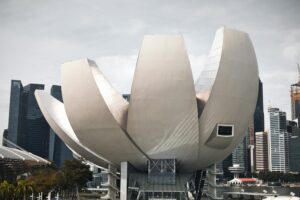 During a recent trip to Singapore, I was reminded how each time I visit this orderly city it evokes a feeling of tranquility amongst the bustle – something I attribute to the Feng Shui principles that have been applied to town planning, architectural design and landscaping.
During a recent trip to Singapore, I was reminded how each time I visit this orderly city it evokes a feeling of tranquility amongst the bustle – something I attribute to the Feng Shui principles that have been applied to town planning, architectural design and landscaping.
Over the years, I have been privileged to visit other Eastern and South-Eastern Asian countries and continually marvel at their cultures. Their philosophies and spiritual practices are deeply rooted in a belief system that we are intrinsically connected to our environment and that this relationship should be honoured and respected. Feng Shui, the ancient Chinese practice dedicated to harmonising this relationship, is based upon this very concept.
My curiosity about Feng Shui began in my teenage years. I read books about it, and delved into crystal healing, Buddhist philosophy, meditation and the Chakras – I even bought the ‘I Ching’ and consulted it regularly. Eventually, I adorned myself – and the apartments I inhabited – with crystals, talismans and I learnt to meditate. By my early 20s, I was a hippy/new age/esoteric young maiden trying to “find myself” whilst exploring how better to live in harmony with the universe.
Although I am not formally qualified in any of the above-mentioned fields, my affinity towards them shaped many of my life choices: one of which was to become a certified yoga teacher.
I am convinced there is a universal truth (or energy system) that binds everything in existence and have found that when I allocate time to contemplating it, my life becomes increasingly peaceful. This concept, one which is embedded in Feng Shui philosophy, has served me well.
So how does this Feng Shui relate to Pilates?
Joseph Pilates reiterated the importance of “Balance of Body and Mind”. He believed that the body, mind and spirit should function “perfectly as a coordinated whole” and considered himself to be “…one who has devoted the major portion of his life to the scientific study of the body and practical application of nature’s laws of life… (pertaining to physical and mental health)”. The connection between nature’s teachings and our bodies was, in part, the foundation of the Pilates method.
In the second chapter of ‘Your Health’ Pilates postulated: “If human beings only knew and only obeyed the simple laws of nature, universal health would follow and the Health Millennium would be here”. Clearly, Pilates believed there was much to learn from our natural environment and that its teachings should be applied to our personal conduct.
Breath and mind control, centring, establishing a sense of flow and seeking harmony between body, mind and spirit are just some of the Pilates principles. “Not too much, not too little” – a well-known Pilates quote – indeed implies balance; it is also one of the premises of Feng Shui.
Some Pilates teachers have a fascination with modalities connecting mind, body and spirit. Others take a step further and expand upon these to include nature and/or their surroundings. In fact, many Pilates studio owners decorate their studios with Pilates principles in mind to create a harmonious workplace.
For those of this mindset, adding a touch of Feng Shui to their studios may assist all who enter to feel balanced and centred.
Feng Shui History
‘Feng Shui’ (pronounced ‘Feng Shoe-ee’ or ‘Fung Shwey’) is an ancient Chinese practice traditionally used throughout China to arrange buildings, spiritual structures and dwellings in auspicious directions to promote harmony between people and their surroundings. Its primary purpose was to ensure that whatever was erected, it either harnessed the power of wind and water or, alternatively, avoid the destruction they may cause; in fact, the literal translation of Feng Shui is “wind-water”.
Initially, Feng Shui masters relied on astronomy and landforms such as mountains, water and holes to decide where to build things; their positioning guided their decision-making. This ancient Feng Shui method is known as the ‘Jiang Xi’ or ‘Form School’.
The ‘Fukien School’ or ‘Li Qi School’ is the other primary Feng Shui stream. It considers landform as well as astrology and geology and relies upon a Chinese compass, the ‘Luo Pan’, which differs from the modern-day compass. It provides information about the full 360 degrees allowing the practitioner to be very accurate regarding a building’s orientation and the energy in any direction. The needle points south and each direction is governed by the ‘Five Element’ theory (see Qi below). Today, the Luo Pan continues to be consulted by traditional and highly-skilled Feng Shui masters.
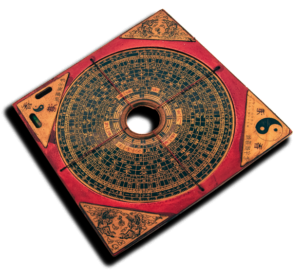
After the creation of the modern-day compass, it became common practice to align directions with the magnetic fields of north, south, east and west, including the four combinations of these.
Another Feng Shui method consults or additionally includes the Ba Gua – an octagonal Feng Shui directional map based on the Luo Pan, which I will expand upon later – for directional guidance.
As Feng Shui evolved, it expanded to include the orienting of structural fixtures such as windows and doors, features including fountains and statues and items like furniture, mirrors, good luck charms and religious or spiritual talismans within the home, workplace and in all other spaces.
Traditional Feng Shui methods are complex and require calling upon an expert, especially if the Luo Pan is being consulted. When building homes, for example, these masters consider not only the directions but also the astrological charts, animal year of birth and magic numbers of the inhabitants. Therefore, many calculations are made.
I have chosen the Ba Gua method as the basis for my Feng Shui words of advice. To fully grasp how to incorporate this method, I highly recommend you refer to the section ‘Feng Shui Concepts’ towards the end of this article.
How to Harness ‘Life Areas’ in Your Pilates Studio (Ba Gua Method)
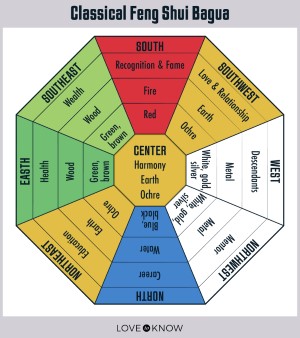
Image: Attribution-Non Derivatives 4.0 International (CC BY-ND 4.0) Created by LoveToKnow Classical Feng Shui Bagua
Today, consulting the Contemporary Ba Gua (there are traditional, older versions which I will not elaborate upon) is one of the most common methods implemented by Feng Shui planers, architects, interior designers and decorators to enhance ‘Life Areas’ such as relationships, prosperity and health.
Begin by placing the Ba Gua map at the point from which you would enter your studio (I enter mine from the top of a staircase and consider it to be the entry). Next, refer to the Ba Gua and follow the guidelines below (note: there are many varied views regarding Feng Shui and consulting an expert is always advised).
Beginning at the bottom of the Ba Gua:
- North is the entry area, north-east is to the left, north-west to the right
- The centre of the room lies straight ahead, east is centre-left, west is centre-right
- Directly ahead and farthest away is south, the farthest left corner is south-east, the farthest right corner is south-west
North
Life Areas: career, financial earnings, beginnings, life journey Element: water Energy: yin Colours: black, blue, dark blue Crystals: lapis lazuli, blue lace agate, blue calcite, hematite, black onyx
A water feature, an image of water, turtles, fish or items that are blue or even black in this area. Placing something that depicts your future career aspirations or an objective that relates to your Pilates or life journey will help activate this area. Mirrors and glass will bring prosperity as will meandering or wavy patterns and asymmetrical shapes.
North-east
Life Areas: knowledge, wisdom, education, skills Colours: blue, light blue, black, green Element: earth/mountain Energy: yin Crystals: brown agate, tigers eye, jade
Earthy objects such as gemstones and crystals will enhance this area. Creating a library or even adding a few books or magazines will help with your path towards becoming wiser. Perhaps place your business pamphlets, anatomy books or posters and other items you use as educative tools here. Ensure to keep this area well-lit as light will energise the earth element. Square shapes are advised.
East
Life Areas: foundation, family, elders, past Element: wood/thunder Energy: yang Colours: green Crystals: emerald, jade, green aventurine, peridot, amythyst
Trees and plants work well in this corner, especially those with blue or purple hues for they feed the wood energy. Wooden furniture, items or Pilates props/apparatus (wooden rollers, dowels and equipment) landscape pictures and paper are auspicious. Placing something that reminds you of your family is another idea. Pillars, columns, rectangles and vertical lines are also recommended.
South-east
Life Areas: abundance, accumulation, prosperity, wealth Element: wood/wind Energy: yin Colours: purple, purple-blue, purple-red, brown Crystals: emerald, jade, aventurine, peridot
Images or statues of fish, turtles or a dragon (associated with luck and prosperity) will bring prosperity to this corner as will trees or plants. If you have a jade statue or carving they would be appropriate here. You could also place a money bowl here with some gold coins or notes inside (be sure that you choose one that is either gold or made from crystal or coloured glass; it should not be transparent as money may then flow outward and not inwards towards you). Rectangular shapes bring good fortune.
South
Life Areas: fame, reputation, journeys end Element: fire Energy: yang Colours: red, orange, purple Crystals: red jasper, garnet, ruby, carnelian, citrine, amethyst, sunstone, gold
Place an image or item that you associate with your desired reputation or a Pilates mentor you strive to emulate (perhaps Joseph Pilates himself!). A representation of the sun, birds and red colours are auspicious. However, too much red may overheat this corner; it is a strong colour so go easy. You could place a lamp to keep this area well-lit or items that have a triangular or pyramid shape.
South-west
Life Areas: relationships, love, friends, mother Element: earth Energy: yang Colours: pink, orange, red, brown, beige, white Crystals: pink tourmaline, red garnet, amethyst, rose quartz
Pairs of objects provide good fortune in this area: Mandarin ducks, vases, pictures of mountains, a pair of Makarlu, chi balls or tortoises. Displaying photos of your loved ones or your clients will enhance your relationships with them. Nurturing items that make you feel safe and loved are auspicious (In my studio, I have placed a small statue of a lady sitting in lotus pose here, crystals and a pair of chi balls). Earthy elements such as clay, stone and terracotta work well. Square shapes are auspicious.
West
Life Areas: creativity, future, projects, children Element: metal/lake Energy: yin Colours: white, grey, silver Crystals: pyritye, howlite, obsidian, citrine, tiger’s eye, white quartz
Metal is great in this corner: a bronze statue (if you are fortunate enough to have one) or any metallic stones. Adding objects that relate to your creativity or aphorisms that relate to your future aspirations will bring fortune. White is a favourable colour for the west so consider a white frame if you are hanging up framed ittems. Coins, round and oval-shaped items will enhance this area.
North-west
Life Areas: neighbours, helpful people, blessing, travel, father Element: metal/heaven Energy: yang Colours: grey, silver, gold, white Crystals: pyrite, obsidian, citrine, opal, white quartz
Metal elements will also energise this area. Items that pay homage to your Pilates community, travel or destination photos, and anything that reminds you to count your blessings are all perfect things to place here. Placing round and oval-shaped objects is recommended.
Centre
Life Areas: physical health Element: earth Energy: yin-yang, Qi Colours: yellow, orange, brown, sandy-earthy tones Crystals: quartz, rose quartz
Ideally, the centre of the room should not be cluttered. It should enable Qi to flow freely so keep it as open as possible.
The energy you give to your life areas is just as important as the energy you wish to receive from them. Respect them by keeping them clean and tidy. You may also choose to regularly give thanks (insert your own special way of doing so here) to any or all areas, especially those with spiritual or religious items.
In addition, there are some fundamental Feng Shui do’s and don’ts that should be adhered to. Apply caution regarding religious or spiritual talismans, the placement of mirrors, entrances, bathrooms and sharp objects – I will not expand on these. If you are keen to learn more and choose to conduct your own research, then I wish you well on your investigative journey.
The Contemporary Ba Gua
“Ba Gua”, is literally translated to “eight house”. It is an octagonal diagram or template that indicates the eight compass directions; north, north-east, south, south-east etc. In most cases it shows the eight I Ching trigrams and their respective element (see ’Feng Shui Concepts’ below) and several life areas pertaining to various aspects of our lives. Frequently, it includes the Yin-Yang symbol at the centre.
When the Ba Gua is placed over the plan of a building, room, outdoor area or any place, it serves as a guide from which to apply Feng Shui concepts and principles to enhance the positive flow of Qi.
To create prosperity in a life area, the Ba Gua should be placed such that the northerly direction is at an entrance: the front door of a room or building or the primary place from which one would enter an outdoor area. If there are multiple entry points, the most common or most important entry is chosen.
Important Note: The directions of the Ba Gua do not accurately align with modern day compass directions. The map always display north at the bottom and south at the top – no matter which actual modern day compass direction one is facing. Traditionalists may choose to align the northerly direction of the Ba Gua with the true northerly compass direction. However, it is imperative that only one of these two methods be chosen; the two should not be combined or used simultaneously as misfortune may ensue.
Feng Shui Concepts
Qi
The premise of Feng Shui is that the flow of ‘Qi’ (also referred to as “Chi”) should flow harmoniously throughout any given space. ‘Qi’, literally means “air”, “breath” or “vapour” and is considered the vital life-force that runs through everything in existence. If one impedes Qi, negative energy and events may follow. In contrast, if one assists Qi to flow naturally they will experience harmony.
This is achieved by acknowledging that one’s external environment impacts one’s internal state – a concept that makes plain sense to most. Equally rational is the belief that one’s environment affects how they conduct their lives and influences good intention: If one seeks order yet lives an environment that is mal-organised, such as having a messy space within the home, then maintaining order will be more difficult. Likewise, if one seeks physical health yet works in a place with a cluttered floor space, they may trip, fall or hurt themselves – no small Pilates equipment lying around, please!
The I Ching
Feng Shui incorporates concepts from the ‘I Ching’: an ancient Chinese book of oracles and wisdom. The I Ching interprets the energies of the universe and is often used for divination.
It comprises 64 hexagrams, each made up of two trigrams which are formed by three broken and/or unbroken horizontal lines. The broken lines represent ‘Yin’ energy (earth, darkness, female, receptive, water, moon), the unbroken lines represent ‘Yang’ energy (heaven, light, masculine, creative, fire, sun).
Each trigram of the I Ching depicts a force of nature: heaven, lake, fire, thunder, wind, water, mountain or earth. These forces guide Feng Shui experts (and those of us less expert) throughout their planning process. In both traditional and contemporary Ba Gua maps a trigram is depicted in each of the eight compass directions.
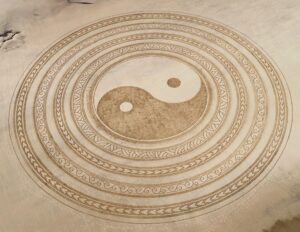
Yin and Yang*
The Yin-Yang theory is associated with many Eastern practices including tai chi, yoga and Ayurveda. Its premise is that both yin and yang characteristics exist in all matter including living beings, nature and man-made objects. Its core philosophy is to establish balance between the two opposing forces whose constant movement acts together to create energy. The forces co-exist providing support to each other; when the energy between them is balanced, so too is everything containing them.
The Directions
Each of the four primary directions correlate to a celestial animal, element and season. Placing items, images or representations of these in their corresponding directions is considered auspicious:
East: The Azure Dragon, Wood, Spring
South: The Red Vermilion Bird, Fire, Summer
West: The White Tiger, Metal, Autumn
North: The Black Tortoise, Water, Winter
The aim of Feng Shui is to harness the energy of the animal, element and season and not to oppose it. For example, the south is governed by fire so placing a water-feature or any representation of water in that area may bring bad fortune. However, placing an image of the red vermillion, the sun or an orange coloured ornament in that area would lead to prosperity.
Five Elements: The Cycles
Importantly, Feng Shui abides by the ‘Five Elements’ theory or ‘Wu Xing’ which proposes that each of nature’s five elements (wood, fire, earth, water and metal) have unique properties and powers that must be balanced correctly – environmentalists, feel free to shout a cheer!
The best way to enhance each direction/life area is by adding items that complement it. In doing so, it is extremely important to abide by and respect the cycles of the elements. As mentioned earlier, you would not want to place water in a fire corner, neither metal in a wood corner. However, if you have too much of an element in an area you can gently use either the exhaustive or destructive cycle to compensate. For example: imagine the north-east, knowledge, earth corner has too much earth energy (stone walls and floors, an orange couch and a metal clock) you could try adding a small amount of the wood element such as plants or wooden items to weaken the earth element. Beware: it is best to avoid compensating for an unbalanced ‘Creative Cycle’ by using the ‘Controlling Cycle’ unless it is necessary. Remember the aim is to balance the energies to assist the flow of Qi – “Not too much, not too little”.
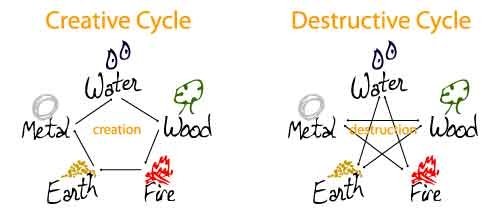
feng shui creative and destructive cycles diagram. Credit: Shandi Greve Penrod. CC BY-SA 3.0 Deed Attribution-ShareAlike 3.0 Unported
*Curious fact: In 2023, quantum physicists discovered that when two photons (light particles) became entangled they formed the symbol of Yin-Yang – very interesting! To learn more visit: https://thequantuminsider.com/2023/08/23/yin-yang-researchers-capture-the-mysterious-dance-of-entangled-photons-in-real-time/
Feng Shui Examples
Some Western cultures have embraced Feng Shui with open arms. However, its prominence in East-Asia is unsurpassable. Feng Shui experts have been, and frequently are, called upon to create prosperity:
- In Singapore, the ArtScience Museum is shaped to represent two palms receiving positive energy.
- The Singaporean government consulted a highly regarded Feng Shui master to resolve the issue of the MRT subway tunnels needing to be built by cutting through the ‘dragon vein’ of the nation: his solution was to create the octagonal one-dollar coin (SGD1.00) to ward off possible economic downfall.
- In Hong Kong, both the Hong Kong and Shanghai Bank and the Bank of China were built in consultation with Feng Shui experts – yet after their constructions, they proceeded to engage in a Feng Shui battle of sorts because the latter’s building directed arrows towards the former and the former, to counter this negative energy, erected mirrored glass to redirect the arrows back towards the latter.
- In Japan, Feng Shui (known as ‘Fusui’ in Japan) was applied to the original creation of Kyoto, Nara and Edo (now Tokyo)… and the list goes on.
Feng Shui is a practice that sparks varied opinion. Some believe it contributes to a harmonious existence whilst others are more sceptical. Irrespective of these views, if applying Feng Shui principles to our lives contributes positively to our sense of well-being and happiness then, in my opinion, let us embrace it!

Comments are closed.